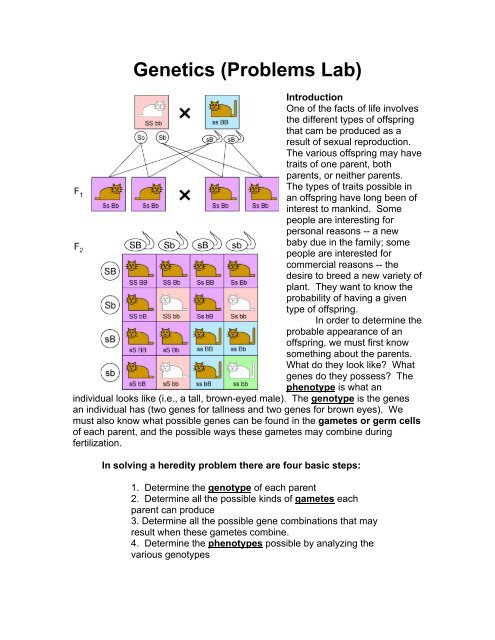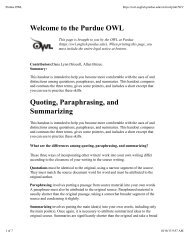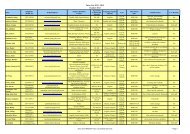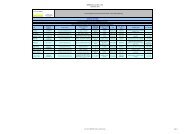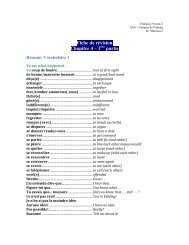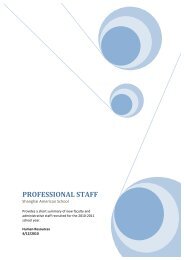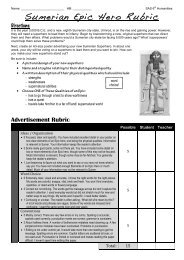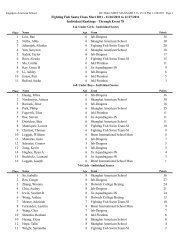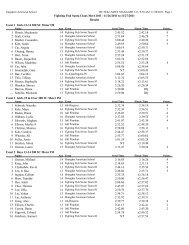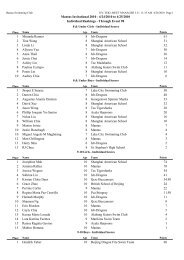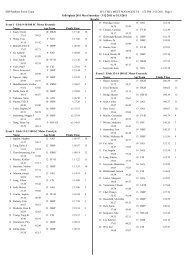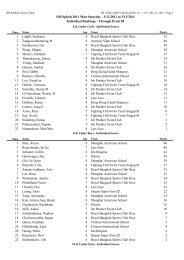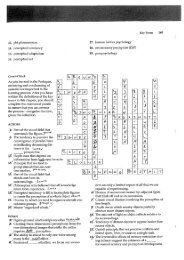Genetics (Problems Lab)
Genetics (Problems Lab)
Genetics (Problems Lab)
You also want an ePaper? Increase the reach of your titles
YUMPU automatically turns print PDFs into web optimized ePapers that Google loves.
<strong>Genetics</strong> (<strong>Problems</strong> <strong>Lab</strong>)<br />
Introduction<br />
One of the facts of life involves<br />
the different types of offspring<br />
that cam be produced as a<br />
result of sexual reproduction.<br />
The various offspring may have<br />
traits of one parent, both<br />
parents, or neither parents.<br />
The types of traits possible in<br />
an offspring have long been of<br />
interest to mankind. Some<br />
people are interesting for<br />
personal reasons -- a new<br />
baby due in the family; some<br />
people are interested for<br />
commercial reasons -- the<br />
desire to breed a new variety of<br />
plant. They want to know the<br />
probability of having a given<br />
type of offspring.<br />
In order to determine the<br />
probable appearance of an<br />
offspring, we must first know<br />
something about the parents.<br />
What do they look like? What<br />
genes do they possess? The<br />
phenotype is what an<br />
individual looks like (i.e., a tall, brown-eyed male). The genotype is the genes<br />
an individual has (two genes for tallness and two genes for brown eyes). We<br />
must also know what possible genes can be found in the gametes or germ cells<br />
of each parent, and the possible ways these gametes may combine during<br />
fertilization.<br />
In solving a heredity problem there are four basic steps:<br />
1. Determine the genotype of each parent<br />
2. Determine all the possible kinds of gametes each<br />
parent can produce<br />
3. Determine all the possible gene combinations that may<br />
result when these gametes combine.<br />
4. Determine the phenotypes possible by analyzing the<br />
various genotypes
Purpose<br />
In this exercise you will be asked to determine the probable type of offspring<br />
when given the necessary genetic information. You will also be asked to arrive<br />
at the genotype of the parents and their offspring.<br />
During this exercise you will be:<br />
1. Working monohybrid problems<br />
2. Working dihybrid problems<br />
3. Determining genotypes and pheonotypes of parents and offspring<br />
Put your answers on your answer sheet. And with all problems, be sure to<br />
show ALL of your work. Make your legends complete and easy to follow!<br />
PART I: Monohybrid <strong>Problems</strong>- (One trait being followed from one<br />
generation to the next.)<br />
1. In humans, six fingers (F) is the dominant trait, and five fingers (f) is the<br />
recessive trait. Both parents are heterozygous for six fingers. What is the<br />
phenotype of the father and the mother? What is the genotype of each parent?<br />
What is the probability of them having six-fingered children? Five-fingered<br />
children?<br />
Father's phenotype (1a) Mother’s phenotype (1b)<br />
Father's genotype (1c) Mother’s genotype (1d)<br />
Father's germ cells __or __(1e)<br />
Mother's germ cells __or __(1f)<br />
Probability of a six-fingered child (1g)<br />
Probability of a five-fingered child (1h)<br />
2. If the father is heterozygous for six fingers and the mother has five fingers,<br />
what is the probability of having these characteristics in the offspring? Six fingers<br />
(2a) Five fingers (2b)<br />
3. In certain flowers, color is inherited by genes that have incomplete<br />
dominance. In such flowers, a cross between a homozygous white and a<br />
homozygous red will always result in a pink flower. A cross is made between<br />
two pink flowers. What is the probability of these colors (red, pink and white)<br />
appearing in the offspring? (3a)<br />
4. Use the information given in the problem number 3. A cross is made between<br />
a red flower and a pink flower. What will be the expected probability for the<br />
various colors? (4a)
PART II: Dihybrid <strong>Problems</strong> - (Two traits being followed from one<br />
generation to the next)<br />
5. In horses, black color (B) dominates chestnut color (b). The trotting gait (T)<br />
dominates the pacing gait (t). A cross is made between a horse homozygous for<br />
black color and the pacing gait and a horse homozygous for chestnut color and<br />
the trotting gait. List the probable phenotypes of offspring that could result if the<br />
offspring from the original cross were crossed among themselves.<br />
Original cross: genotype (5a) phenotype (5b)<br />
Cross of the offspring. (Handle this like a separate problem. Take who<br />
individuals from the original cross.) (5c)<br />
6. Humans may have Rh+ blood or Rh- blood. A person with Rh+ blood or Rh-<br />
does not have this particular protein in his blood. In humans, Rh positive blood<br />
dominates Rh negative blood. Normal insulin production dominates abnormal<br />
insulin production (diabetes). If both parents are heterozygous for Rh positive<br />
blood and normal insulin production, what probable phenotypes would they<br />
produce with these traits? (6a)<br />
7. For this problem use the information concerning the traits given in problem 6.<br />
The father is homozygous for Rh-positive blood and has diabetes. The mother<br />
has Rh negative blood and is homozygous for normal insulin. What probable<br />
phenotypes would they produce with these traits? (7a)<br />
8. In the radish plant the long and round traits are incompletely dominant and<br />
result in an oval shape. The red and white color traits are incompletely dominant<br />
and result in a purple color. Two plants both oval-shaped and purple are<br />
crossed. What would be the phenotypic ratio in their offspring? (8a)<br />
9. In certain breeds of dogs, black color is dominant and red color is recessive,<br />
solid color is dominant and spotting is recessive. A homozygous black and white<br />
spotted male is crossed with a red and white spotted female. What is the<br />
probability of them producing a solid black puppy? (9a)<br />
10. In humans, there is a type of blindness due to a dominant gene; normal<br />
vision is the result of a recessive gene. Migraine headaches are due to a<br />
dominant gene, and normal (no headaches) is recessive. A male who is blind<br />
and does not suffer from headaches marries a woman who has normal vision<br />
and suffers from migraines. Could they produce a child with normal vision and<br />
does not suffer from headaches? (10a) If yes, can the probability of such a child<br />
be determined? (10b)
PART III: Linked trait <strong>Problems</strong> - (Genes located on one chromosome that<br />
affect different traits)<br />
11. In humans, the condition for normal blood clotting dominates the condition<br />
for nonclotting (hemophilia). Both genes are linked to the X chromosome. A<br />
male hemophiliac marries a woman who is a carrier for this condition. (In this<br />
respect, a carrier is a woman who has a gene for normal blood clotting and a<br />
gene for hemophilia.) What are the chances that if they have a male child he will<br />
be normal for blood clotting? (11a)<br />
12. For this problem use the information given in problem 11. A male who has<br />
normal blood clotting marries a woman who is a carrier for this condition. What<br />
are the chances that if they have a son he will be normal for blood clotting? (12a)<br />
13. In humans, the condition for normal vision dominates color blindness. Both<br />
genes are linked to the X chromosome. A color-blind male marries a color blind<br />
female. If they have a daughter, what are the chances that she will have normal<br />
vision? (13a)<br />
14. For this problem use the information given in problem 13. A normal-visioned<br />
male marries a color-blind woman. She gives birth to a color-blind daughter.<br />
The husband claims the child is not his. The wife claims the child is his. Can<br />
you support the argument of either parent? (14a) If yes, which one? (14b) Why?<br />
(14c)<br />
PART IV: Multiple Allele <strong>Problems</strong> - (Characteristics which have more than<br />
two possible alleles forms)<br />
15. In humans, the trait for A type blood and B type blood show incomplete<br />
dominance, so that a person with both genes has blood type AB. Both A and B<br />
dominate type O. A person with a gene for type O blood marries someone with a<br />
gene for type B blood and type O blood. List the types of offspring they could<br />
have and the probability for each blood type in the offspring. (15a)<br />
16. For this problem use the information given in problem 15. A young lady with<br />
type O blood gave birth to a baby with type O blood. In a court case she claims<br />
that a certain young man is the father of her child. The man has type A blood.<br />
Could he be the father of the child? (16a) Can it be proven on this evidence<br />
alone that he is the father? (16b)<br />
17. In humans, nappy (kinky) hair, curly hair, wavy hair, and straight hair are<br />
dominant in that order. Dark hair dominates red hair. A wavy, red-haired male,<br />
who had a straight dark-haired mother, marries a straight, dark-haired female,<br />
who had a curly red haired father. What type of children can they produce and<br />
what is the probability of producing these types of offspring? (17a)
18. Normal pigmentation dominates no pigmentation (albino). In order for an<br />
organism to exhibit color, it must have a gene for normal pigment production as<br />
well as genes for a specific color. In cattle red color dominates black. An albino<br />
bull that has a heterozygous genotype for red is crossed with a red cow. The<br />
cow is heterozygous for normal pigment production and for red coloring. What<br />
types of offspring will they produce and what will be the probability for producing<br />
these types of offspring? (18a)<br />
Note: All the polygenic inheritance problems in this exercise involve two different<br />
traits; therefore, they are all dihybrid problems.<br />
19. In some types of wheat, color is caused by two sets of genes. Both<br />
dominant genes, R and B are needed for red color. White results from both<br />
recessive genes in the homozygous state, rrbb. Any other combination will<br />
produce brown wheat grains. A strain with a genotype of Rrbb is crossed with a<br />
strain of wheat with a genotype of rrBb. What is the color of each of the parent<br />
strains? (19a) What color wheat will result from this cross and what is the<br />
probability for each color? (19b) Rrbb color _______rrBb color_______<br />
20. In humans, normal pigmentation dominates no pigmentation (albino). Black<br />
hair dominates blonde hair. An albino person will have white hair color even<br />
though they may also have the genes for black or blonde hair color. An albino<br />
male who is homozygous for black hair marries a woman who is heterozygous<br />
for normal pigmentation and who has blonde hair. What colors of hair can their<br />
children have and what is the probability for each hair color? (20a)<br />
Determination of Genotypes- (what you see and what you get.) Not all types of<br />
heredity problems deal with determining the phenotype of the offspring. There is<br />
a type of problem where the phenotypes of both of the parents and the offspring<br />
are known and you wish to determine the genotype of each individual.<br />
In humans, brown eyes are dominant and blue eyes are recessive. Two browneyed<br />
people marry and produce one brown-eyed child and two blue-eyed<br />
children. What is the genotype of the parents and each of the children?<br />
Since the parents are both brown-eyed, they must have at least one gene for<br />
brown eyes so their genotypes would be B____ (the ___ means the gene could<br />
be either the dominant allele or the recessive allele). The genotype for the blueeyed<br />
children must be bb. Since each parent contributed one gene to each blueeyed<br />
offspring, you know that each brown-eyed parent has a gene for blue eyes.<br />
Therefore, the ___ must be a b and the genotype for each parent is Bb. All you<br />
know about the brown-eyed offspring is that it has one gene for brown eyes, the<br />
genotype could be BB or Bb.
In the remaining problems, attempt to determine the genotypes of the individuals.<br />
Take it slowly, only put down a gene when you are certain the individual has that<br />
gene. If you are not certain, merely show that you don't know by leaving a blank<br />
____.<br />
21. Normal pigmentation (A) dominates no pigmentation (albino=aa) Brown eyed<br />
coloring (B) dominates blue-eyed coloring (bb). Two people with normal<br />
pigmentation produce one brown eyed, and two blue eyed, and two albino<br />
children. What is a possible genotype for the parents? (21a)<br />
22. A red bull when crossed with white cows always produces roan colored<br />
offspring. Explain how the colors for red, white, and roan are inherited. (22a)<br />
23. In rabbits, short hair is due to a dominant gene L, and long hair to its<br />
recessive allele I. Black fur is due to a dominant gene B, and white hair to its<br />
recessive allele b. When two rabbits were crossed they produced 2,518 shorthaired<br />
black and 817 long-haired black offspring. What are the probable<br />
genotypes of the parents? (23a)<br />
24. In humans, the condition for normal blood clotting dominates hemophilia.<br />
Both genes are sex-linked to the X chromosome. Two parent produced<br />
daughters who are all carriers and sons who are all normal. What are the<br />
probable genotypes of the parents? (24a)<br />
25. In humans, deafness is due to a homozygous condition of either or both<br />
recessive genes d and e. Both the dominant genes D and E are who all have<br />
normal hearing. What are the probable genotypes of the children and parents?<br />
(25a)


